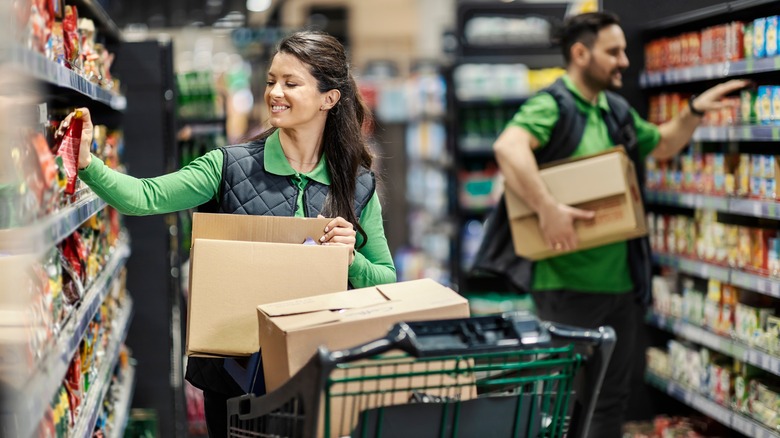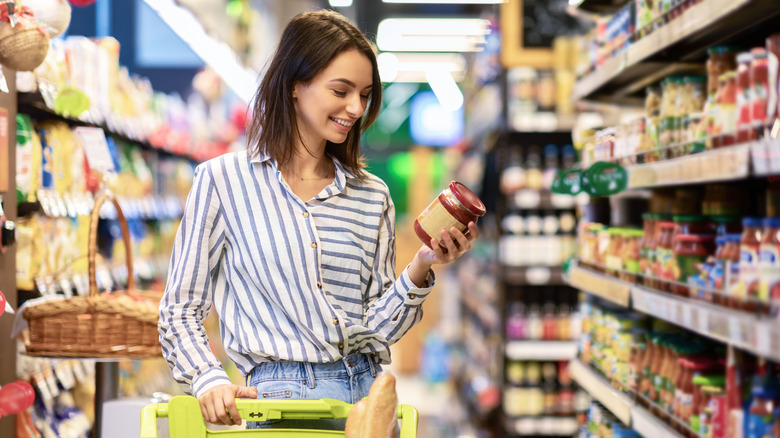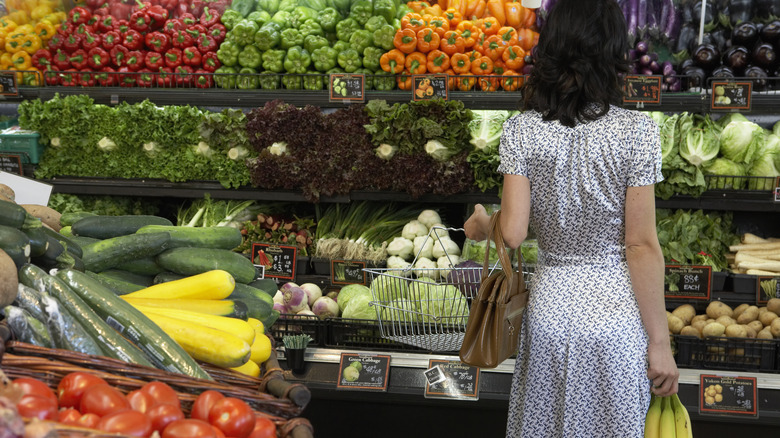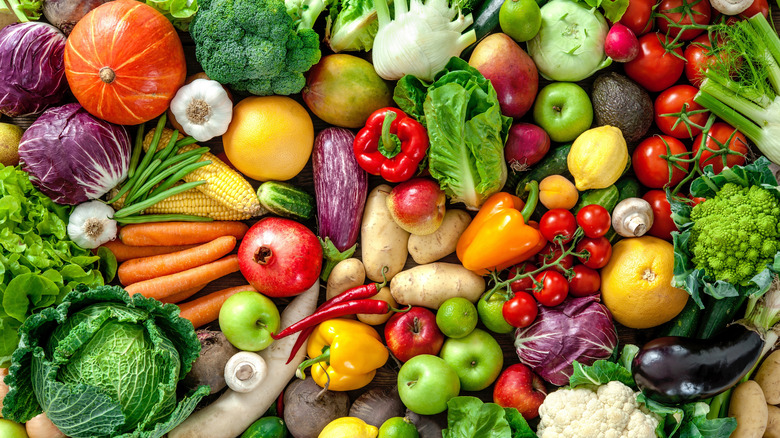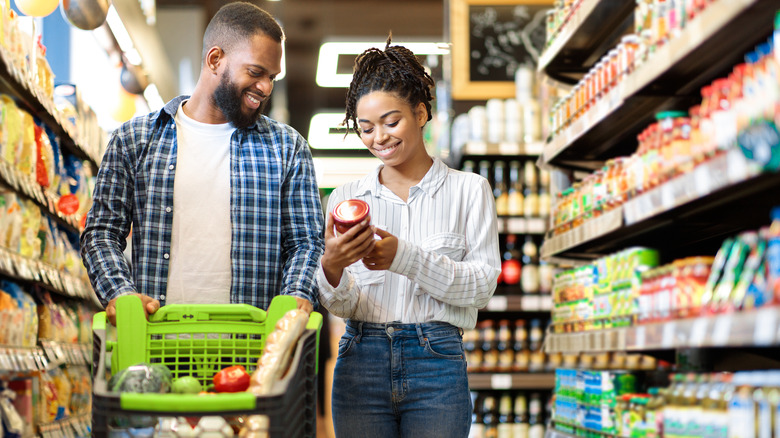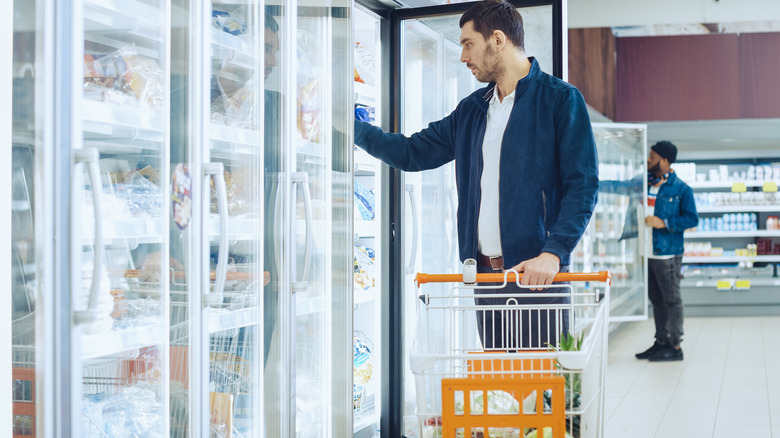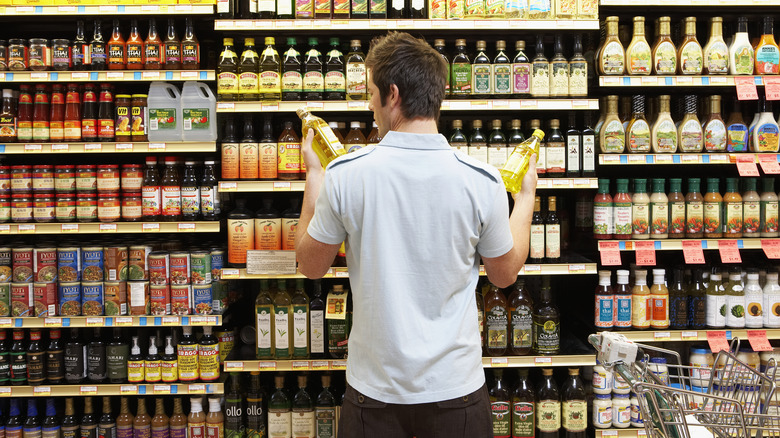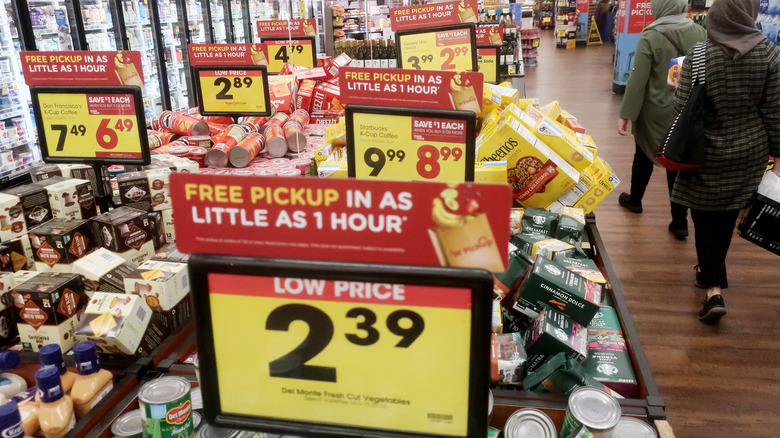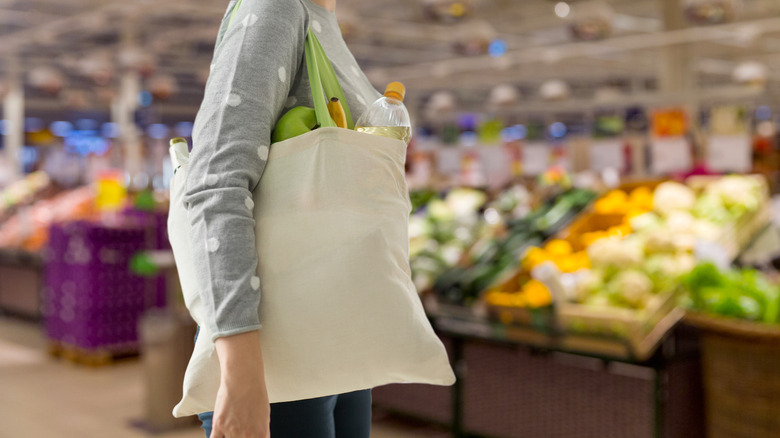Try These 12 Grocery Store Hacks And Thank Us Later
For the majority of people, grocery shopping is not high on their list of fun activities. Whether you do it daily or weekly, it takes a lot of time and money to get in and out with what you need. And sometimes, you end up coming out with way more than that.
Effective grocery shopping is a skill. Some people seem to have a knack for it — knowing exactly what they need and where to look for it — while others wander aimlessly, only to get home and realize they forgot a crucial ingredient. Or, they went to the store for salad ingredients and came home with a bag of chips and a pint of ice cream. Whoops.
A lot of this comes down to planning. If you hate how much time grocery shopping takes, or you're trying to eat healthier, or you're trying to save money, learning these hacks can help you make trips to the store more efficient and enjoyable.
Go at the right time of day
The best time of day to go to the grocery store is when it's the least crowded. First thing in the morning when the store opens or at night just before closing time, you'll find empty aisles and short checkout lines.
If you don't want to fight other carts for a space in the aisles, you should avoid the grocery store during peak hours. According to a survey by the United States Department of Agriculture Economic Research Service, the busiest hours on weekdays are between 11 a.m. and 2 p.m. and between 3 p.m. and 5 p.m. On weekends, the busiest hours are between 10 a.m. and 2 p.m.
The least busy times in the survey were between 8 and 9 a.m. and between 7 and 8 p.m. on weekdays and weekends. If your preferred grocery store opens earlier or later than that, those will surely be your best hours to shop stress- and crowd-free.
In addition to taking into account when the store is the least crowded, you should also consider when is the best time for you. If you can barely keep your eyes open in the morning, going at 7 a.m. probably isn't going to be that enjoyable for you. If you're rushing to pick up the kids, but trying to hit the market before it gets busy, you might avoid the crowds, but you won't avoid the stress. Crowded or empty, do your shopping when it's best for you.
Shop the perimeter of the store
If you're watching your weight or trying to improve your overall well-being, here's a health-focused hack: Shop the perimeter of the store first, and only go into the aisles if there's something on your list you really need. This is because all of the fresh food is found around the outside of the aisle — produce, meat, fish and seafood, eggs, and dairy. Fresh food is always your best bet for keeping healthy and fit.
The aisles are filled with processed foods, which often have a lot of salt, sugar, and fat in them. None of those are good for your health in excess. When you shop for fresh foods, you don't have to read labels or worry about amounts because they are naturally lower in fat, sodium, and sugar. Processed foods often also contain preservatives because they're required to make them shelf-stable.
That's not to say that there aren't any healthy foods in the aisles — there definitely are. Some of those include whole grains, such as brown and black rice and quinoa; whole-grain, low-sugar bread; beans; nuts and nut butter; and healthy oils, such as olive oil. When you do go into the aisles, do so with laser focus. Pass right by the sugar and salt-laden sweets and snacks and go right for the good stuff — then get out.
Shop local and in season
With each season, you might see more of some foods and less of others at your grocery store. What's in season depends on where you live. In Arizona, March brings a bevy of asparagus, cabbage, broccoli, lemons, spinach, tangerines, and turnips. In June, you'll see fresh blackberries, blueberries, figs, green beans, zucchini, leeks, and nectarines.
Seasonal produce is your best bet when you're looking for freshness and flavor. Out-of-season produce is still available, but it's flown in from all over the country — and the world. These long travel times can cause produce to lose some of its nutritional value and flavor.
Seasonal produce is also sustainable. It has a lower carbon footprint because fewer emissions are required to get it to your table (via Glasgow Science Centre). Buying local produce is also better for the local economy, helping to create and sustain jobs in your area.
Lastly, seasonal produce tends to be less expensive. This is because there are lower costs associated with getting it to the store. It's also a matter of supply and demand. When a food is in season, there's more of it. That often means it will be sold at cheaper prices than scarce produce.
Shop the deals
Grocery shopping can really add up. According to the Bureau of Labor Statistics, Americans spent almost $5,000 on food at home, or about $415 a month. The good news is that you can shave quite a bit off your bill by seeking out deals and shopping smart.
Watch for your store's weekly ads to come out, which for most markets is on Wednesdays. These circulars are going to have the hottest new deals that you'll want to jump on ASAP, as they will sell out fast. If you snooze too long, don't worry. If the products are still in stock, stores will typically honor the previous week's sale prices.
It's easier to just shop one store for everything you need, but that's not the best way to save money. Certain items you use regularly are often priced differently from store to store. Make a list of those items and where you can find them cheaper, and plan to pick them up there when you are passing by.
You can save an average of 27% on food by purchasing generic store brands rather than name brands (via Consumer Reports). Name brands spend a ton of money on building recognition through marketing, and they build that cost into the product price. Generic products often have the same ingredients, but none of the extra cost. It's not always a guarantee that the store brand will be just as good as the name brand, but it's worth a try.
Don't snub frozen produce
Frozen foods are often maligned, either for being processed junk full of fat and sodium or for being less nutritious than fresh foods. While that's true for many frozen meals, pizza, and desserts, it's not true for frozen fruits, vegetables, fish, and meat. In fact, these frozen items can be just as, or even more, nutritious than their fresh counterparts.
Fruits and vegetables are most nutritious and flavorful when they're picked at the peak of ripeness. Once they're harvested, they quickly begin to lose nutrients and flavor via exposure to light and air. Freezing directly after harvesting stops these losses and preserves the produce until it is defrosted for use.
One study compared the effects of refrigeration and freezing on fruits and vegetables. Researchers found that fresh and frozen retained similar amounts of many nutrients, including vitamins C, E, and the B vitamin riboflavin; minerals such as calcium, magnesium, zinc, iron, and copper; dietary fiber; and antioxidant compounds called phenolics. In some cases, frozen foods retained more nutritional value than fresh produce.
Frozen produce can also be less expensive than fresh, especially when it comes to out-of-season items. You can also save money by preventing food waste when fresh food goes bad before you can use it. Another thing you'll save when you buy frozen is time. No need to wash, chop, or peel them — just take them out of the bag and add them to your favorite recipe.
Take advantage of coupons
People pass coupon-clipping off as a waste of time, but if you know what to look for, you can save big. Store and manufacturer coupons can get you significant discounts on single products and BOGOs (buy one, get one). If you know you're going to use a product regularly and you spot a BOGO, grab it. If you see a product you've been wanting to try but haven't because you don't want to invest in the full price, take advantage of the discount and give it a go.
You can also stack coupons and look for double coupon days. Stacking coupons means using a manufacturer's coupon on top of a store coupon. On double coupon days, you can use one coupon but get twice the discount.
Coupon clipping can be complicated because there's a lot of fine print. But once you get the hang of it, you'll be raking in the savings. Just be careful, because couponing can actually be harmful, too. Don't buy something you don't need just because there's a coupon. Only use coupons for items that are already on your list so you don't end up spending more than you save.
Sign up for store rewards programs
Most of the major nationwide grocery stores have loyalty and rewards programs. By joining these programs, you can get discounts, freebies, and other rewards that can save you cash and lighten the effects of inflation on your wallet.
Albertsons for U gets you $5 off your first purchase, a free birthday treat, one free item a month, rewards points, and more. You'll earn one point for every $1 you spend. After you rack up 100 points, you get a reward. Collect five rewards and you'll get $7 off; 10 rewards get you $15 off; and 12 rewards take $20 off your entire order.
Club Publix also gives you $5 off your first order, a sneak peek of the weekly circular one day before it's released, a free birthday treat, a digital wallet with perks, and an app with digital coupons and notifications for BOGOs and other sales.
Giant's Flexible Rewards program offers point rewards for every purchase that you can use on grocery savings and to get discounts on gas. For groceries, you'll save $1 for every 100 points you redeem, and you can save $0.10 on each gallon of gas at Giant and select Shell stations. You'll also get new offers each week for free products.
Plan before you shop
Meal planning is a great way to make sure you're eating healthily and economically and not buying more than you need. If you want to do complete meal planning, you can reserve one day to choose your recipes for the week, shop for all the ingredients you need, and package your meals for each day so they're ready to go when you need them.
Even if you don't want to full-on meal plan, you should still plan in advance. Having a list before you go to the store can make your shopping trip more efficient and save you time and stress. Having a list can prevent you from forgetting things you need and coming home with things you don't need.
If you want to be really prepared, divide your list by grocery sections. What do you need in the produce aisle, butcher and seafood counters, condiments, and dry foods aisles? Arrange your categories in order from aisle to aisle so you don't have to double back for things you forgot. Check off items and sections as you go through the store.
You can also keep a master list of the things you buy each week, so you can automatically add those to the list without having to think about it. Also, make sure to check your refrigerator and cabinets for things on your list that you might already have enough of, as it's common to buy things you already have.
Don't grocery shop when you're hungry
If you skipped lunch and your tummy is growling, afternoon trips to the grocery store are a bad idea. This can cause you to make bad choices that are based on cravings, rather than the nutritious foods you planned to buy (via NIH).
Science confirms this. A study in JAMA divided 68 participants into two groups — one that ate crackers before going shopping, and another group that was told to abstain from eating for five to six hours before their shopping trip (via the American Council on Science and Health). The results showed that the group who hadn't eaten was more likely to purchase high-calorie foods than the group that had the crackers first.
Make sure you've had a meal or at least a snack an hour or two before shopping. If you have to, grab a package of pre-washed carrot and celery sticks when you first arrive at the store and munch on those as you're shopping. Having a list that you stick to with self-discipline can also help you avoid impulses.
Avoid common grocery store marketing tactics
Grocery stores have all sorts of secret ways to make you buy more than you planned. Foods around the perimeter of the store — produce, meat, bread, and dairy are not only more nutritious but are also often less expensive. More expensive processed foods are typically found in the aisles, so avoid those as much as possible.
Beware of special sales tactics, such as getting a deal when you buy more than one of something. For example, buy 10 yogurts for $5. The truth is that you don't actually need to buy all 10 to get the discount. You can buy just one and still save 50 cents. Unless the sales notice specifically says that you must buy all 10 to get the discount, you don't have to.
Comparing prices can also help you save money. Two bags of chips may be the same price, but one bag might have slightly less in it. It's better to read the shelf labels and look at the price per pound, ounce, or pint rather than the item price. This is the objective way to figure out which is the better deal.
Lastly, when you're checking out, watch the screen on the register to make sure you're being charged correctly. Sometimes, due to human error, prices aren't correct in the system. Sale items also sometimes don't register as the sale price for the same reason.
Shop online for delivery or pick up
Really want to save time and energy? Don't go to the grocery store. Shopping from the comfort of your home or office can help you avoid traffic, lines, and impulse buys. Shopping without the stress of being in the store makes it easier to plan ahead and stay within your budget because you can easily look for items at the lowest price. One way to do this is to sort your search — say, for carrots — from the lowest prices to the highest prices.
Online shopping also helps you plan ahead because you can create your shopping list online and add to it throughout the week before you head to the store. If delivery comes at a high cost, you can typically pick up your groceries at the store, which still helps you save time by not actually having to do the shopping yourself. You might also get free delivery if you spend a certain amount. If you've never shopped online before, take some time at first to learn the process — how to search for items, filter items you don't need, and sort the product page according to relevance or pricing.
Most stores will let you pick substitutions should anything be out of stock. You can also add notes to be more specific about what you're looking for. Just be sure to stay by your phone while the shopper is picking up your products because they might call or message you with a question or offer a substitute.
Bring your own bags
Plastic bags are bad for the environment. According to the Center for Biological Diversity, it takes 1,000 years for a plastic grocery bag to break down in a landfill. The U.S. is among the worst offenders, with Americans using 365 plastic bags per person, on average, each year. Comparatively, in Denmark, the number is four plastic bags per person per year.
Sea turtles will thank you, as nearly 35% of the leatherback species have been found dead with ingested plastics. Your wallet will also thank you, as many stores are beginning to charge for plastic bags. In Colorado, the cost of a shopping bag is 10 cents as of January 1, 2023. Single-use plastic bags have been banned, so you won't even have an option for those.
If you have trouble remembering to bring your own bags here are a few tips: As soon as you are home and you've unloaded your grocery bags, take two minutes to put the bags back in your car. Set a timer for about 5 to 10 minutes after you have put away your groceries just in case you get sidetracked by a couple of spoonfuls of peanut butter from that brand-new jar (we don't judge). If going to the car is too much, just put them by the door so you can't miss them when you leave for your next shopping trip. You can also place a sticky note on the front door or on the dashboard of your car.
